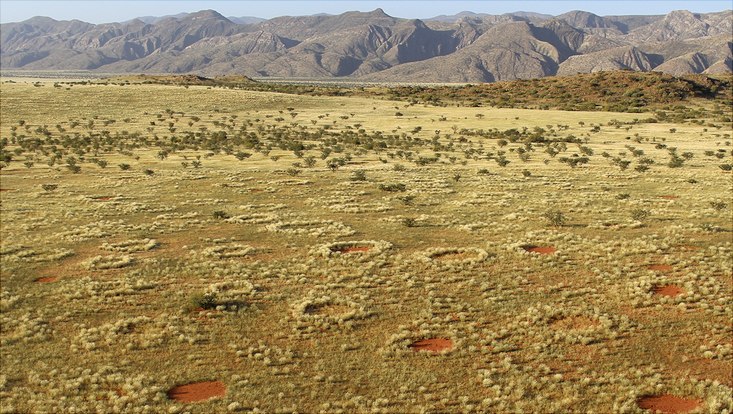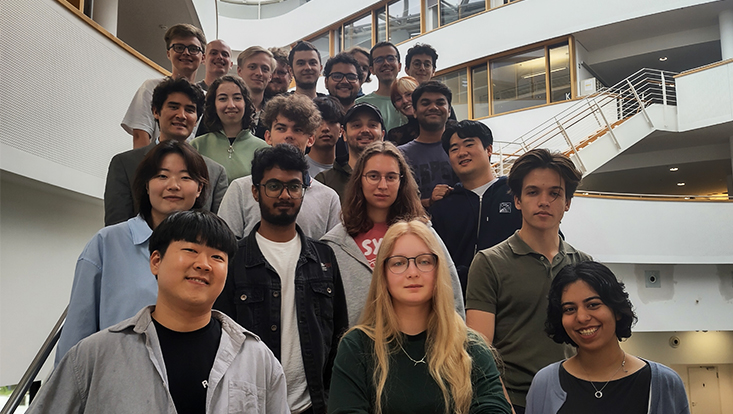and Natural Sciences
Termites enhance biodiversityNew book on Africa's biodiversity published
20 December 2022, by MIN-Dekanat

Photo: UHH/MIN/Jürgens
An international research team from Germany, southern Africa and the USA studied the functional role of social insects in the ecosystems of the drylands and savannas of southern Africa, for more than a decade. Led by the Department of Biology at Universität Hamburg, the researchers now present the results in a comprehensive book volume of 376 pages with nearly 800 figures and tables.
The famous "Fairy circles of the Namib Desert” serve as an entry point to a much wider discussion of ecosystem engineering caused by social insects. The mysterious fairy circles of the Namib Desert are large round patches of bare ground, which form regular patterns on permeable, sandy soils in the grasslands at the edge of the desert. The causative agents of these fairy circles have been identified by Norbert Jürgens, head of the Biodiversity Working Group in the Department of Biology at Universität Hamburg. They are sand termites of the genus Psammotermes, which live underground in a fragile tunnel system.
These termites create the bare patches by killing the grasses in a circular area, allowing rainwater to rapidly percolate into the deeper soil where the moisture remains stored for years. In contrast, in the surrounding landscape, the living grasses absorb rainwater through their roots and consume it with their transpiration, within a few weeks.
In the book, numerous other vegetation patterns and the corresponding causative processes are presented for the first time. The 15 authors from various disciplines present their extensive data material and, at the same time, illustrations, maps and tables that will help future researchers gain access to the organisms.
"With this book, we showcase the important role of social insects and especially termites, which shape and stabilize the properties of southern Africa's landscapes and ecosystems," says Norbert Jürgens. "A diversity of social insects create novel ecosystems with properties and resources that enable survival of a rich dependent biodiversity. They are able to partially buffer the damage caused to natural ecosystems by climate change and land-use change."
In the grasslands at the margin of the Namib Desert, life is limited to short-lived pulses of development following infrequent rains, while a rich perennial fauna lives permanently on, underneath and around the water-storing fairy circles, despite the extreme desert conditions. In the course of evolution, well-adapted species have evolved in these moist islands. As part of the PhD thesis of Felicitas Gunter from the Department of Biology, a phylogenetic tree was re-constructed and several new species were detected, within the termite genus Psammotermes. At the same time, complex communities of interacting animals and plants have evolved, which are published in a chapter headed by Joh Henschel, former director of the Gobabeb Desert Research Station in Namibia.
The monograph also includes modeling of the soil water balance in and adjacent to the fairy circles, conducted by Alexander Gröngröft of Annette Eschenbach's research group at the Department of Earth System Sciences at Universität Hamburg. Their study is based on soil hydrological data stored by automatic measurement systems over more than 14 years in different regions of the Namib Desert.
In addition to the fairy circles, the book also presents highly visible termite colonies with above-ground structures up to heights of several meters. The termite species responsible for these mounds manipulate both the moisture and the chemical properties of the soil. Many of the termite burrows are extremely hard and serve to protect the colonies and their mushroom gardens. In grass-covered swamplands in Zambia, termites form meter-high islands on which trees grow. An extensive chapter by Joe McAuliffe, former director of the Phoenix Botanical Garden in Arizona, introduces the "Little Hills" of the South African Karoo, formed by termite-triggered accumulations of wind-transported sand and dust.
Further information
The book was published by Klaus Hess Verlag on December 20, 2022:
www.k-hess-verlag.de/index.php/neuerscheinungen/92-fairy-circles
Jürgens, N., et al. (2022) Fairy circles of the Namib Desert – Ecosystem engineering by subterranean social insects. (= Biodiversity & Ecology, 7). 376 pp. Klaus Hess Publishers, Göttingen & Windhoek


